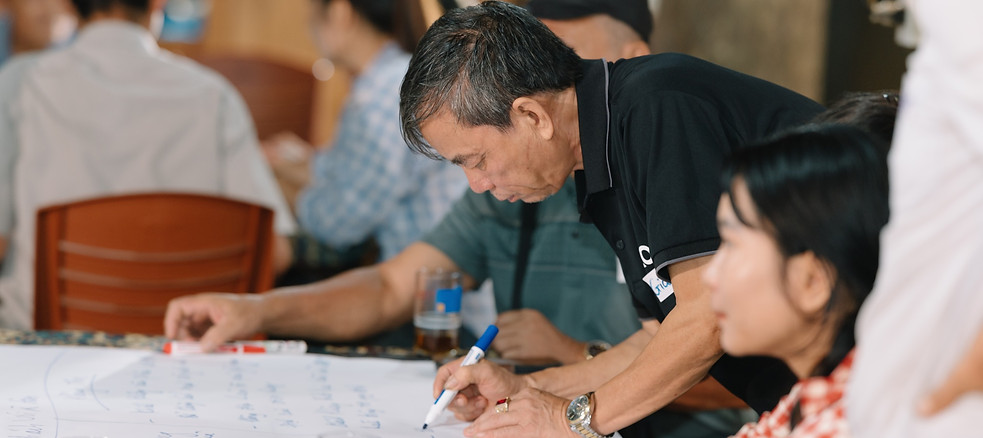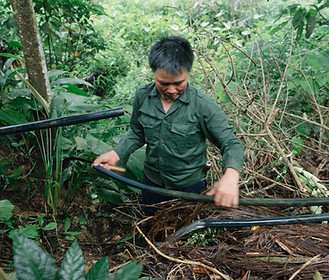LEED O+M for Small Accommodations: A Roadmap to Green Operations
This training was delivered to the representatives of homestays and accommodation facilities in the Pù Luông tourism area, Thanh Hóa province, Vietnam. It was not intended to certify any facility or the region, but rather to introduce baseline knowledge about green building certifications and how they function. The goal was to lay the groundwork for future emission and carbon footprint reduction in tourism - anticipating that such practices will soon become industry requirements.

What is LEED and LEED O+M
LEED, short for Leadership in Energy and Environmental Design, is a globally recognized green building certification developed by the U.S. Green Building Council (USGBC) in 1998. It provides a framework for healthy, efficient, low-carbon, and cost-saving buildings, and is used in over 180 countries and territories.
LEED encompasses nine rating systems, covering different building types and phases - from new construction and interior design to homes, schools, and neighborhoods. Among these, LEED for Operations and Maintenance (LEED O+M) is specifically designed for existing buildings, focusing on optimizing performance.
The system evaluates performance across five major categories: energy, water, waste, materials, and indoor environmental quality. It encourages practical steps such as improved cleaning practices, efficient water use, and smarter energy consumption.

Photo: Magnolia's representative during the LEED O+M workshop
In the tourism sector, LEED has gained traction among resorts, ecolodges, and sustainable accommodations aiming to align their operations with environmental standards and enhance visitor trust.
For small and medium-sized accommodation facilities, LEED O+M provides a scalable entry point to sustainability. Even without structural renovations, operators can begin to adopt greener practices and track their environmental performance.
Importantly, applying LEED O+M sets a primitive milestone - establishing a baseline to calculate greenhouse gas emissions and carbon footprint. This is a critical first step toward climate responsibility and long-term sustainability.

Adapting LEED O+M v4.1 to Small & Medium Accommodation Facilities
When we talk about sustainability in the built environment, it’s easy to think LEED only applies to skyscrapers or big hotels. But the LEED O+M v4.1 rating system - Operations and Maintenance - is designed specifically to work with existing buildings, including small-scale rural accommodations like homestays.
The current version, LEED O+M v4.1, emphasizes performance over construction. That makes it highly adaptable for community-based tourism models, where facilities are often already built and deeply rooted in the local environment.
In places like Pù Luông, where Magnolia introduced the application of LEED O+M to homestays, we realized that even with limited budgets and traditional building materials, there are plenty of practical steps operators can take.
Let's explore how LEED O+M can be applied to the small and medium facilities, grouped around few key categories:

1. Location and Transportation
-
Encourage the use of bicycles or electric bikes to reduce emissions and promote guest well-being.
-
Clearly designate bike parking and promote its benefits to guests and the community.
2. Sustainable Sites
-
Rainwater management can be achieved by creating natural ponds at the lowest points of the property.
-
Reduce the urban heat island effect by restoring shade trees or using vegetated roofs.
-
Limit light pollution through shaded, directional lighting — especially important in eco-destinations for wildlife.
The Scorecard, with a total of 100 points.
Photo provided by Magnolia's LEED expert
3. Water Efficiency
-
Install water meters for all primary uses (showers, kitchens, irrigation).
-
Collect 12 months of water data to identify trends and improve efficiency.
-
Use collected rainwater for landscaping and non-potable needs.
4. Energy and Atmosphere
-
Track and reduce energy use through simple metering and monthly reporting.
-
Install solar PV or use biogas where possible to reduce grid dependency.
-
Maintain preventive schedules for HVAC, lighting, and kitchen appliances.
-
Use natural ventilation and refrigerants with low global warming potential (e.g. R32).
5. Materials and Resources
-
Develop a green purchasing policy, prioritizing reusable and local products.
-
Separate and monitor waste streams: organic waste, recyclables, hazardous waste (like batteries and bulbs).
-
Use products with circular life cycles — like refillable soaps, glass water bottles, and compostable materials.

Photo: Mr. Giap, a homestay owner and resident of Don Village during the training workshops
6. Indoor environmental quality
-
Ensure cross-ventilation, clean air, and ceiling fans in guest rooms.
-
Install entry mats and follow green cleaning protocols to reduce indoor pollutants.
-
Regularly measure CO2 and TVOC levels, and survey guest comfort annually.
How to Apply for LEED O+M Certification
To begin the LEED O+M certification process for an existing accommodation facility, it is essential to first meet the basic eligibility and documentation requirements. These are necessary to demonstrate building ownership, operational maturity, and environmental performance.
Minimum Requirements for LEED O+M Eligibility
-
Ownership and Documentation
-
Valid proof of building ownership or long-term lease.
-
Complete set of as-built architectural and MEP drawings (if available).
-
-
Performance Data Collection
At least 12 months of continuous records prior to submission:-
Electricity and water bills (monthly).
-
Waste management data, including:
-
Total waste weight per month.
-
Waste categories (e.g., organic, recyclable, hazardous).
-
Records of onsite treatment or offsite disposal.
-
-

Photo: Local people in Don Village setting up tubes to redirect natural water to their home.
Submission and Certification Process
-
Submit Documentation - Round 1
-
Register your project and obtain a LEED Project ID via the USGBC platform.
-
Upload project details, data reports, and credit documentation.
-
USGBC reviews and responds within 5 weeks.
-
-
Respond to Feedback
-
Address any reviewer comments and submit clarifications or corrections.
-
-
Submit Documentation – Round 2
-
Final submission of all documents.
-
Second review conducted within 5 weeks.
-
-
Receive Certification
-
Upon approval, your facility receives an official LEED O+M certificate, valid for 3 years.
-
-
Post-Certification
-
Continue tracking monthly performance metrics.
-
Maintain updated green policies and records to prepare for recertification.
-
